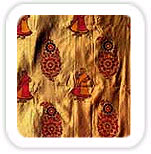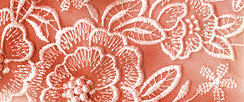
Aari embroidery is done primarily by the Muslim cobbler community in
India. The designs are of Mughal origin since the art was at one time
patronized by them. By using subtle gradations of color the figures and
motifs in the designs can be highly representational. Aari at times is
also called zari work. The zari thread or the metallic thread if quite
commonly used in this style of embroidery. It is done with colored
thread as well using color gradations to make the motifs and figures
highly representational.
Process
The word aari comes from the hooked needle used in the embroidery
called the aar. It is similar to the one used in crochet.
The fabric is first fixed over the frame often made of bamboo. The
pattern is traced on it and the embroidery work begins. A needle with a
hooked end and Zari (gold or silver) or cotton or silk thread are used.
Ari looks like a fine chain stitch. The needle is pushed through the
fabric. From behind, thread is pushed into the hook. When the needle is
pulled up again, it comes up with a loop. The next time, the needle goes
through the loop and comes up with another loop through the previous
loop. The same process is repeated. The stitches are very fine and
small.
Very intricate embroidery is done with the ari technique. The tension
of the thread has to be maintained whole working. After the embroidery
part is over the stitches are beaten using a wooden mallet from the top
on a handheld wooden anvil placed under the fabric. It is an art carried
by men. Women are not supposed to learn this art.





